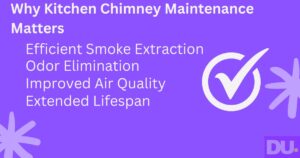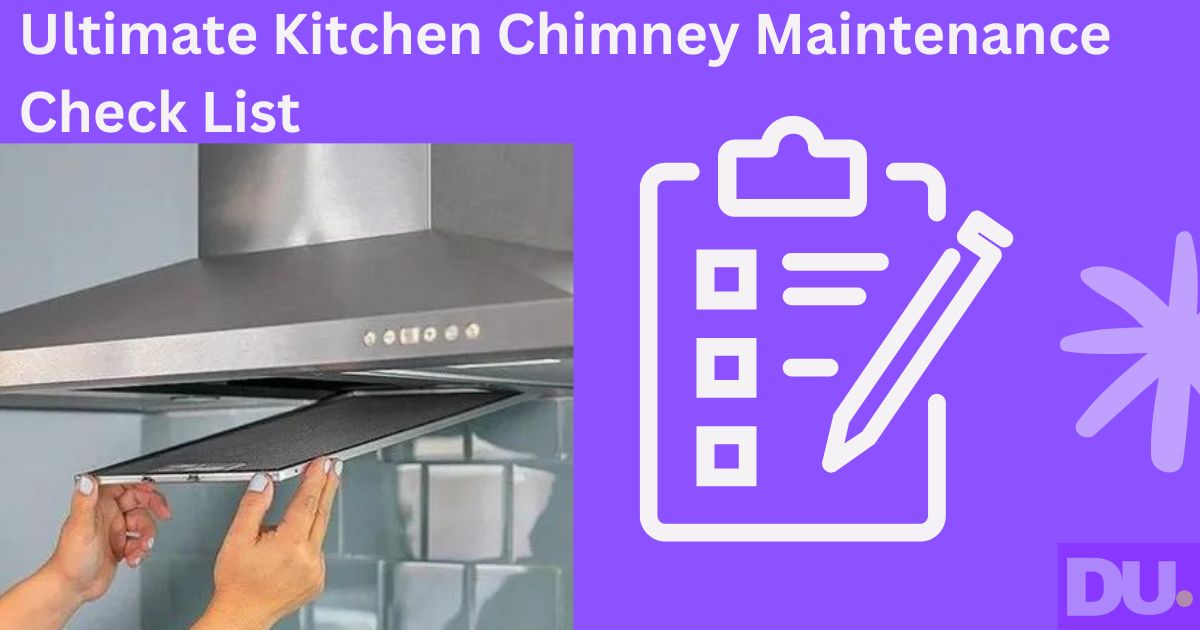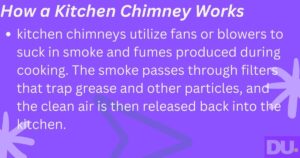Kitchen Chimney Maintenance Check List
Introduction
Welcome to our comprehensive kitchen chimney maintenance checklist! Kitchen chimneys are essential appliances that keep your kitchen free from smoke, grease, and odors, making your cooking experience more pleasant.
To ensure that your chimney functions optimally and lasts for a long time, regular maintenance is crucial. In this blog post, we will cover everything you need to know about maintaining your kitchen chimney, from basic cleaning to troubleshooting common issues.
A kitchen chimney is an essential appliance that helps keep your kitchen free from smoke, odors, and grease. Regular maintenance of your kitchen chimney is crucial to ensure its optimal performance and longevity.
Why Kitchen Chimney Maintenance Matters
Before diving into the maintenance checklist, let’s understand why regular upkeep of your kitchen chimney is so important:
-
Efficient Smoke Extraction: A well-maintained chimney efficiently extracts smoke and harmful fumes from your kitchen, making it a healthy space for cooking.
-
Odor Elimination: Regular maintenance ensures that your kitchen remains free from unpleasant odors, making it a more enjoyable place to cook and dine.
-
Improved Air Quality: By removing grease and airborne particles, a clean chimney contributes to better indoor air quality, promoting a healthier living environment.
-
Extended Lifespan: Proper care and maintenance can significantly extend the lifespan of your kitchen chimney, saving you money on premature replacements.
Now that we understand the importance of maintaining our kitchen chimneys, let’s proceed with the maintenance checklist:
1. Understanding Your Kitchen Chimney
1.1 Types of Kitchen Chimneys
Before we dive into the maintenance process, let’s briefly discuss the different types of kitchen chimneys available in the market. Understanding the type of chimney you have is essential as maintenance techniques may vary based on the design.
-
Wall-mounted chimneys
-
Island chimneys
-
Built-in chimneys
-
Corner chimneys
-
Downdraft chimneys
1.2 How a Kitchen Chimney Works
To better grasp the maintenance procedures, it’s essential to know how a kitchen chimney works. In simple terms, kitchen chimneys utilize fans or blowers to suck in smoke and fumes produced during cooking. The smoke passes through filters that trap grease and other particles, and the clean air is then released back into the kitchen.
2. Regular Cleaning and Maintenance
2.1 Cleaning the Filters
The filters are the heart of your kitchen chimney and require regular cleaning. There are primarily three types of filters used in chimneys:
-
Mesh Filters: These are made of aluminum mesh and are ideal for trapping grease. They need cleaning every two weeks.
-
Baffle Filters: Constructed with multiple curved panels, baffle filters efficiently separate grease and smoke.
-
Charcoal Filters: These filters are optional and used in ductless chimneys to eliminate odors. They usually need replacement every 3-6 months, depending on usage.
To clean the filters, follow these steps:
-
Remove the filters from the chimney as per the manufacturer’s instructions.
-
Soak the filters in hot, soapy water for 15-20 minutes.
-
Gently scrub the filters with a soft brush to remove stubborn grease.
-
Rinse the filters thoroughly and let them dry before reinserting.
2.2 Cleaning the Exterior
The exterior of your chimney can accumulate dust and grime over time. Regular cleaning not only keeps it looking good but also prevents the build-up of dirt that can affect the chimney’s performance.
-
Use a damp cloth to wipe down the exterior surface of the chimney.
-
For stainless steel chimneys, a mixture of mild detergent and water can be used to restore shine.
2.3 Duct Cleaning
If you have a ducted kitchen chimney, the duct that connects the chimney to the outside can get clogged with grease and debris. Periodic cleaning is essential to maintain optimal airflow.
-
Hire a professional duct cleaning service every 6-12 months, depending on usage.
-
Ensure that the duct is properly sealed to avoid any leakage of smoke or fumes.
3. Troubleshooting Common Issues
3.1 Chimney is Noisy
Is your kitchen chimney making strange noises?
Check if the chimney is properly mounted and not loose.
-
Clean the fan and the blades to remove any accumulated dirt.
-
If the noise persists, contact a professional technician for further inspection.
3.2 Reduced Suction Power
If you notice a decrease in the suction power of your chimney, there could be several reasons behind it:
-
Check the filters for clogs and clean them if necessary.
-
Inspect the duct for any obstructions or blockages.
-
Verify that the chimney’s size is adequate for your kitchen space.
3.3 Chimney Emitting Foul Odor
A kitchen chimney should eliminate cooking odors, not spread them around. If you encounter foul smells:
-
Clean the filters to remove accumulated grease and debris.
-
Ensure that the charcoal filters (if present) are not due for replacement.
-
Consider using an exhaust fan along with the chimney for better odor removal.
4. Safety Measures
4.1 Electrical Safety
As with any electrical appliance, kitchen chimneys require proper handling to avoid accidents. Follow these safety measures:
-
Regularly inspect the cord for any signs of damage and replace if necessary.
-
Never operate the chimney with wet hands.
4.2 Fire Hazard Prevention
A kitchen chimney deals with smoke and grease, which can pose a fire hazard if not handled carefully:
-
Avoid using highly flammable substances near the chimney.
-
Clean the filters regularly to prevent grease build-up, reducing the risk of fire.
-
Install a smoke detector in your kitchen for added safety.
5. When to Call a Professional
5.1 Annual Maintenance
Even with regular DIY maintenance, it’s essential to schedule an annual service by a professional technician.
They can perform a thorough inspection and address any underlying issues that may not be apparent during routine cleaning.
5.2 Unusual Smells or Sounds
If you notice unusual odors or sounds coming from your chimney, it’s best to call a professional immediately. Ignoring such signs could lead to more significant problems and higher repair costs.
Conclusion
Maintaining your kitchen chimney is vital for its efficient functioning and longevity. With our detailed kitchen chimney maintenance checklist, you can now take care of your chimney.
Remember to clean the filters regularly, inspect for any issues, and follow safety precautions to ensure a safe and pleasant cooking experience.
FAQs
Q1: How often should I clean my kitchen chimney filters?
A1: The frequency of cleaning depends on the type of filter you have. Mesh filters need cleaning every two weeks, baffle filters every 3-4 weeks, and charcoal filters every 3-6 months.
Q2: Can I use a chimney without an exhaust duct?
A2: Yes, you can use ductless chimneys that come with charcoal filters, which absorb odors and release clean air back into the kitchen. However, ducted chimneys are more efficient in removing smoke and fumes.
Q3: Is it safe to install a kitchen chimney near a gas stove?
A3: Yes, it is safe to install a kitchen chimney near a gas stove. In fact, it is recommended to have the chimney positioned directly above the cooking area for optimal performance.
Q4: How do I know if my kitchen chimney needs repair?
A4: If your chimney is making unusual noises, emitting foul odors, or experiencing reduced suction power, it may require repair. Calling a professional technician for inspection is the best course of action.
Q5: Can I replace the kitchen chimney’s filters myself?
A5: Yes, you can replace mesh and baffle filters on your own after cleaning them. However, charcoal filters usually need to be replaced by professionals.
Read More Click

